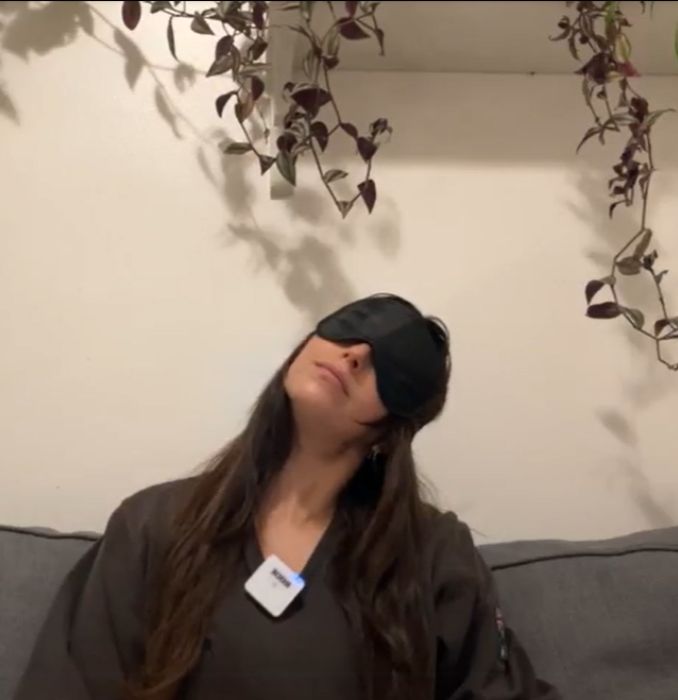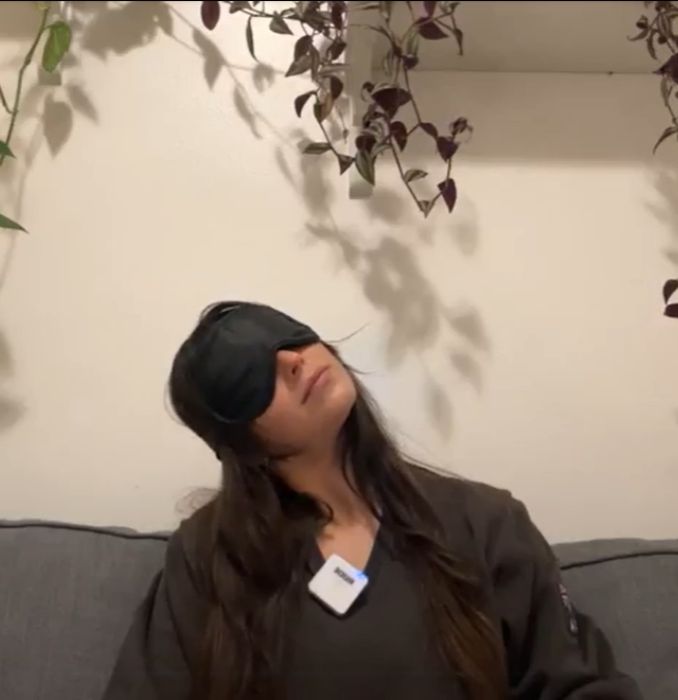
Clarity Meditation: Unburden Your Mind
Before we begin with clarity meditation, as adults, we inevitably encounter the daunting task of generativity, where we grapple with the responsibility of improving ourselves in our various roles. This phase of life often plunges us into tangled thoughts and an ambiguous vision of our future, making it challenging to navigate our daily existence. In such moments, the quest for mental clarity and tranquility becomes paramount.
In these guided clarity meditation techniques, we set out on a journey of greater mindfulness, carefully designed to bring us clarity and peace and reduce stress. This clarity meditation practice helps us find a clear path to our goals, ensuring we lead a balanced and fulfilling life. By focusing our minds and calming our thoughts, we can navigate our lives with greater purpose and find the direction we need to achieve our dreams.
The Practice
1. Intention Meditation

Begin clarity meditation in an upright sitting position with your legs crossed in front of your body, while maintaining good alignment with your head, shoulders, and hips. Then, close your eyes gently, or use a blindfold to create a soothing darkness, allowing a deep sense of calm to soothe your tired eyes.
Relax your face, forehead, and eyebrows, and expand your awareness to not only include your body but also the essence of everything around you.
Let this practice be a haven for cleansing and mental clarity. As you journey inward, focus on your breath, paying close attention to each inhale and exhale. With each breath, release any tension, cradling your body in a peaceful feeling of serenity.
2. Mindful Breathing
Begin in an upright sitting position with your legs crossed in front of your body, while maintaining good alignment with your head, shoulders, and hips. Bring your hands over your lap. Begin with a slow, deep breath through your nose. Bring close attention to your breaths. As you inhale, feel the rise of your abdomen, allowing your belly to expand fully as the breath flows into it.
With your hands as guides, inhale deeply, feeling the breath journey from your belly to your heart. Exhale slowly, releasing any emotions or thoughts that no longer serve you. With each breath out, you are creating space for positivity and serenity.
Continue this pattern of deep inhalation through your nose and a mindful exhalation, connecting your heart and your belly with your breath.
3. Box Breathing

Begin sitting on the floor with your legs crossed in front of your body, maintaining good alignment with your head, shoulders, and hips. Lower your hands cand close your eyes, then take a slow deep belly breath in through your nose, counting to 4 seconds, then hold your breath for another 4 seconds. Lastly, slowly exhale through your mouth for 4 seconds, holding your lungs empty for the last 4 seconds. Repeat the movement.
With each inhale imagine that you're breathing in a sense of freedom from debugging thoughts. Consequently, with each exhale release the pressure of these unclear thoughts. Incorporate this simple breathing technique into your daily meditation practice.
4. Detachment-Visualization Meditation
For this clarity meditation technique, sit comfortably with your legs crossed in front of your body, while maintaining good alignment with your head, shoulders, and hips. Bring your hands over your lap.
Then, as you maintain close attention to your breathing, bring out the thoughts that are burdening your mind and the thoughts that you prioritize to keep. Afterwards, imagine yourself alone in a quiet room divided by a red line. Let this line represent a boundary.
Take a moment to assert your thoughts and imagine them as actual stuff that you can put off. As you take a deep breath, feel the sensation these thoughts are giving you, acknowledging the weight or the heaviness of carrying them.
Then, as you take a deep exhale, put down these insignificant things to the left side of the room and release whatever negative emotions that were associated with them. Afterwards, take a moment to clear your thoughts and unburden your heart.
With every breath, imagine drawing in a fresh breath of cool air, filling your lungs with clean and refreshing oxygen. Once more, think of the red line that's dividing the room. Imagine yourself approaching this line and crossing to the other side.
Lay your priorities and the thoughts that truly matter to you on the side of this room. Picture yourself sitting with these things that you choose to prioritize and simply acknowledge how you feel at the moment.
As your mind wanders, gently redirect your attention to your breath, breathing in through your nose, out through your mouth. With this, you've consciously sorted through your mental clutter, distinguishing between what no longer serves you and what's truly important.
5. Welcoming Opportunity Meditation
Begin in an upright sitting position in a quiet space with your legs crossed in front of your body, while maintaining good alignment with your head, shoulders, and hips. Bring your hands over your lap. Bring close attention to your breaths. As you inhale, feel the rise of your abdomen, allowing your belly to expand fully as the breath flows into it.

Sometimes, we think we need to take every chance we get because we're scared of missing out. But right now, let's just let go of those thoughts. Breathe in and out, and with each breath, feel more relaxed and less worried about grabbing every opportunity. You are not defined by these survival instincts; there is a vast horizon of possibilities waiting for you. Because you are worthy of a greater opportunity.
With each breath, open your heart to the abundance of the universe. Trust in the journey, knowing you don't have to cling to just anything. Feel the freedom and space to choose what truly resonates with your soul.
Afterwards, embrace this moment and cultivate greater mindfulness, welcoming the opportunities that align with your true path. Let this feeling of openness and trust guide you as you gently return to the present, carrying this clarity, calmness, and positive impact into your day.
6. Bright Light Visualization

Begin clarity meditation in an upright sitting position in a quiet space with your legs crossed in front of your body, while maintaining good alignment with your head, shoulders, and hips. Bring your hands over your lap. Begin with a slow, deep breath through your nose.
Afterwards, take a moment to imagine a white ball of light located in between your eyebrows. With every inhale you take, imagine it moving towards your crown chakra and back to the forehead. When your mind wanders, gently bring your focus back to the light.
Then, picture this ball of light slowly turning from white to a rich purple light. As you take a deep breath in, this ball of purple light slowly opens into an illuminating lotus flower, spinning and circling around your forehead. This lotus flower represents our connection to our higher self. Sit with the feeling, allowing the lotus to return back in stillness, as it closes and returns back to a white ball of light.
Now, allow this ball of light to travel toward the center of the heart, letting the sensations arise. As you maintain attention to your breathing, let this light move down further, stopping just below your navel. With a few breaths, let it continue to move further down to your root chakra or base of the spine while it slowly turns a bright red light. Acknowledge the sensation of the grounding energy this creates.
Keep breathing slowly and feel how nice it is to be connected to ourselves. When you're ready, you can slowly open your eyes and come back to the body, feeling more relaxed and connected.
Closing The Practice
-
Body Scan Meditation
In this basic mindfulness meditation, begin in an upright sitting position in a quiet space with your legs crossed in front of your body, while maintaining good alignment with your head, shoulders, and hips. Bring your hands over your lap. Bring close attention to your breaths. As you inhale, feel the rise of your abdomen, allowing your belly to expand fully as the breath flows into it.
Start by bringing your attention to your toes. Notice any sensations as you slowly move your focus through each toe, feeling any warmth, tingling, or relaxation. Gradually shift your awareness up through your feet, to your ankles, observing any feelings without judgment.
Now, gently guide your attention up your legs, feeling the muscles in your calves and thighs release any tension. When you reach your hips, pause to acknowledge how they support your body, letting any tightness melt away.
Next, focus on your abdomen and chest, feeling your breath move in and out, your belly rising and falling. Allow this calming energy to flow into your back, relaxing each vertebra from your lower back to your shoulders.
Bring your awareness to your hands, moving through each finger, then up your arms, releasing any held stress. When you reach your shoulders, let them drop away from your ears, easing any tension.
Lastly, focus on your neck, the base of your skull, and move up to the crown of your head. Feel any weight lifting off, allowing a sense of calm to wash over your entire body. Breathe deeply, embracing the tranquility enveloping you.
-
Mindful Gentle Movements
As we conclude our clarity meditation practice, let's transition gently back to the physical world with some mindful, gentle movements. Start by slowly bringing your awareness back to your body, feeling the surface beneath you supporting your weight.
Begin with your toes. Wiggle them softly, feeling each toe awaken with light, gentle motions. Allow this awakening to spread to your feet, rotating your ankles softly, noticing any sensations that arise.
Now, let's move to our fingers. Shake them gently, feeling the lightness and the subtle energy moving through each finger and palm. Bend your wrists softly, welcoming movement back into your arms.
Gently tilt your neck from side to side, easing any remaining stiffness. Allow your head to move slowly, nodding gently, acknowledging your body's work during the clarity meditation.
Take a deep breath in, and as you exhale, introduce some gentle overhead stretch by interlacing your fingers and extending your arms above your head with your palms facing the ceiling, feeling your spine lengthen. With each gentle movement, feel more present, more aware, and more connected with your surroundings.
As you complete these movements, gradually open your eyes, absorbing your environment with a renewed sense of calm, awareness, and loving-kindness. Meditation fosters mindfulness and gentle energy with you as you move forward into your day.
 |
 |
 |
Conclusion
Meditation is a soothing journey toward tranquility and focus, offering a sanctuary when our minds feel difficulty concentrating on our responsibilities.
Nowadays, people have become more innovative in promoting wellness. Meditation apps have been developed to provide a variety of accessible techniques to invite calm into our lives.
Furthermore, the Gentle Stretching Facebook Page extends this nurturing environment, offering guided meditations and gentle stretches that ease both body and mind. This sense of community enhances our practice, encouraging a shared path to clarity.
Proactively nurturing our mental health with these tools helps us manage stress, cultivate inner peace, and maintain a balanced perspective. By prioritizing our mental wellness, we equip ourselves to navigate life's challenges with resilience and grace, ensuring our well-being remains at the forefront of our daily lives.
There are those who claim that yoga is not suitable for someone who suffers from anxiety. However, yoga can be quite helpful in preventing and managing its symptoms and keeping them at bay.
If you have anxiety disorders, such as panic disorder, OCD, or social anxiety, this program may help you reduce symptoms. This program is also helpful for beginners as well as people with physical limitations.
Check out our Yoga to Calm Anxiety just for you!

